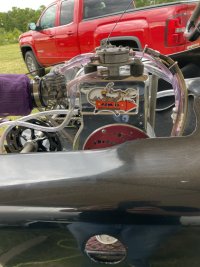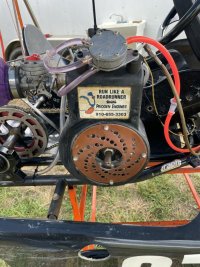You are using an out of date browser. It may not display this or other websites correctly.
You should upgrade or use an alternative browser.
You should upgrade or use an alternative browser.
Briggs Flathead History Lessons
- Thread starter FlatheadsForever87
- Start date
Ok I’m new to the kart building so where did you source the ole flaties from? Old tillers, snow blowers? I have a pressure washer out back with a Briggs & Stratton quantum X 6.75 hp 190 cc. I’d like to build something with real power for our off-road go kart I picked up for me and the kids to build. It has a 6.5 Tecumseh on it with a plastic cam shaft. That seems like a terrible idea for what me and the kids will put it through.
One Fast Kat
Member
Those GT machine engines will be the best engine you ever had. He really knows how to build them. Machine work is perfect.
CarlsonMotorsports
Site Supporter
We will likely be the "last man standing" supporting the Briggs flathead engine platform. We still LOVE our old school flatheads.
We have all parts (oem and aftermarket in stock) and still build new and used (fresh) flatheads from mild to wild.
For what you are doing though, you might be better served with something more durable like an LO206 or even a mild Honda GX390 big block build.
If there's ever anything we can help you with, please feel free to give us a call at the shop, message me on here, through our Facebook page, or email.

-----
 Thanks and God bless,
Thanks and God bless,
Brian Carlson
Carlson Racing Engines
Vector Cutz
www.CarlsonMotorsports.com
Carlson Motorsports on Facebook
33 years of service to the karting industry ~ 1Cor 9:24
Linden, IN
765-339-4407
bcarlson@CarlsonMotorsports.com
We have all parts (oem and aftermarket in stock) and still build new and used (fresh) flatheads from mild to wild.
For what you are doing though, you might be better served with something more durable like an LO206 or even a mild Honda GX390 big block build.
If there's ever anything we can help you with, please feel free to give us a call at the shop, message me on here, through our Facebook page, or email.
-----
Brian Carlson
Carlson Racing Engines
Vector Cutz
www.CarlsonMotorsports.com
Carlson Motorsports on Facebook
33 years of service to the karting industry ~ 1Cor 9:24
Linden, IN
765-339-4407
bcarlson@CarlsonMotorsports.com
Mac_49
Member
Here's an oldy from a grand prix they used to run in my hometown.So does anybody have any old files they can repost here?
Mac_49
Member
When it came to motor mounts....having 5, 10, 15, etc degree mounts...was there any advantage to them over others?
I understand clearance was a factor for chassis and tires and such...but were there any mechanical advantages to any of them? I'm thinking about efficiency with the splash lube system, the gas tanks, heat dissipation and so on. Just based off of the angle of the motor.
I understand clearance was a factor for chassis and tires and such...but were there any mechanical advantages to any of them? I'm thinking about efficiency with the splash lube system, the gas tanks, heat dissipation and so on. Just based off of the angle of the motor.
CarlsonMotorsports
Site Supporter
Oil: We use a 15* mount because it tilts the engine forward enough to get the oil to gather/puddle at the front of the sump and have the dipper just catch it as it passes through with 12-14 ounces of oil. This keeps the gathering oil away from the crank throws and cam gear some and helps reduce parasitic drag.When it came to motor mounts....having 5, 10, 15, etc degree mounts...was there any advantage to them over others?
I understand clearance was a factor for chassis and tires and such...but were there any mechanical advantages to any of them? I'm thinking about efficiency with the splash lube system, the gas tanks, heat dissipation and so on. Just based off of the angle of the motor.
I've got a clear sidecover here that I machined out of Lexan-type material to observe what the oil was doing inside the engine while running on the dyno. What I learned was that most of the oil is whipped into a mist in the crankcase and that "puddle" at the front of the sump becomes very small, but does indeed collect the oil at the front of the block. This is also a reason that everyone went to "0" WT oil.
Fuel: Before 15* mounts, we used to cut and weld the tanks for clearance of the RR tire. Absolute pain and time consuming. The 15* mount also got the tank cap up away from the sloshing fuel. Then the consideration came for the upper cup in the tank when the tank was filled for the feature - not to fill the tank above the back seam to prevent fuel from covering the cup overflow and causing the engine to run full rich. Then along came Happy Caps and some of the pavement guys went back to flat or 5* mounts to lower the center of gravity slightly and still be able to hold a full fuel load. The dirt guys remained with 15* mounts for clearance reasons of the RR tire and the fact that these tanks all leak bad enough already.
"J'-remy
Member
All the limiteds i know ran a flat mount because of no tank and i would suspect the lower CG. i guess we had no clue about the oil issue. i ran a 5 degree mount on my predator because of the float bowl angle and not being able to alter the carb. any pumper style carburetor has no issue. i heard you can run a tillotson sideways or upside down.
CarlsonMotorsports
Site Supporter
Yea, limited mod is a different deal for the fuel tank -- I was referring to stockers in post #29.
Even on dirt, a lot of guys used flat mounts for limiteds and opens - I think mostly because of the cheesy 2 piece mounts that some ran and how much the bottom of the block flexed. We used to add a 3/8" plate between the mount and the block just to help stiffen the bottom of the block on bigger builds. Then we'd take an old number panel and make a mudflap for between the RR tire and the air filter. The angled down & out intake manifold also helped airflow - that was before we had Superflow digital flow benches and such...a Simmons carb comparator showed good/better/best.
Even on dirt, a lot of guys used flat mounts for limiteds and opens - I think mostly because of the cheesy 2 piece mounts that some ran and how much the bottom of the block flexed. We used to add a 3/8" plate between the mount and the block just to help stiffen the bottom of the block on bigger builds. Then we'd take an old number panel and make a mudflap for between the RR tire and the air filter. The angled down & out intake manifold also helped airflow - that was before we had Superflow digital flow benches and such...a Simmons carb comparator showed good/better/best.
Ohiopuller82
Member
Our family pulls garden tractors with kseries kohlers . I try to get info for flathead engine performance from everywhere all the info. I have found on this site has been amazingLately I have noticed the Flathead section has been rather stagnant unfortunately. So in an attempt to breath some life into it i figured we could do a weekly Tech Type Q and A or something. Possibly a retype of all the lost threads pre server crash. Idk
CarlsonMotorsports
Site Supporter
We've built a couple of the 31CI Kohlers over the years for pulling. That cast iron can take a while to port! Especially when compared to doing Briggs aluminum flatheads.Our family pulls garden tractors with kseries kohlers . I try to get info for flathead engine performance from everywhere all the info. I have found on this site has been amazing
Mac_49
Member
Another genuine question....what were the differences between limiteds, limited mods and opens? I would assume opens were pretty straight forward 'no rules' but am curious if otherwise.
To add on....I wasn't around flatheads local so my knowledge of classes is limited. So if there's classes in-between those or some I'm missing out or stated wrong on please enlighten me.
To add on....I wasn't around flatheads local so my knowledge of classes is limited. So if there's classes in-between those or some I'm missing out or stated wrong on please enlighten me.
In the late 80's, IKF flathead classes were; stock, superstock, limited modified, dual stock, and open.
Superstock was stock engine with the addition of a spec size tillotson carb.
Limited modified allowed any rod and piston in stock overbore, stock valve sizes with no porting, any camshaft and springs,stock spec head with only valve clearance mods, tillotson carb, and stock flywheel and ignition.
Open was as the name implies, only cubic inches being limited.
In the 90's, Frank Maasen introduced the blue wazoom. It was a sealed engine with spec cam and carb, aftermarket rod. Somewhere between the super and limited.
Of course, porting, etc was allowed later, then aftermarket rods, etc.
Superstock was stock engine with the addition of a spec size tillotson carb.
Limited modified allowed any rod and piston in stock overbore, stock valve sizes with no porting, any camshaft and springs,stock spec head with only valve clearance mods, tillotson carb, and stock flywheel and ignition.
Open was as the name implies, only cubic inches being limited.
In the 90's, Frank Maasen introduced the blue wazoom. It was a sealed engine with spec cam and carb, aftermarket rod. Somewhere between the super and limited.
Of course, porting, etc was allowed later, then aftermarket rods, etc.
The blue wazoom was an attempt at a sealed engine, with the intent that all would be equal. So a little more power than stock, with the emphasis on driver and chassis setup.The Blue Wazoom also had cnc porting . I assume to a spec as well .
The class came about the same time as the glass beading by Briggs, so, makes sense to cnc port to try to make equal.
West Iowa Tool had a good supply of cnc machines. In the 80's, Uncle Frank's engines carried that name on the blower housing.
Not sure if they were cool bore engines, although that was most popular at that time for stock classes.
FlatheadsForever87
Member
Well I'm back though it doesn't seem like I have missed to awful much. How the heck have you all been getting along?

